automatic transmission CHEVROLET CAMARO 1998 4.G Owners Manual
[x] Cancel search | Manufacturer: CHEVROLET, Model Year: 1998, Model line: CAMARO, Model: CHEVROLET CAMARO 1998 4.GPages: 402, PDF Size: 21.2 MB
Page 69 of 402
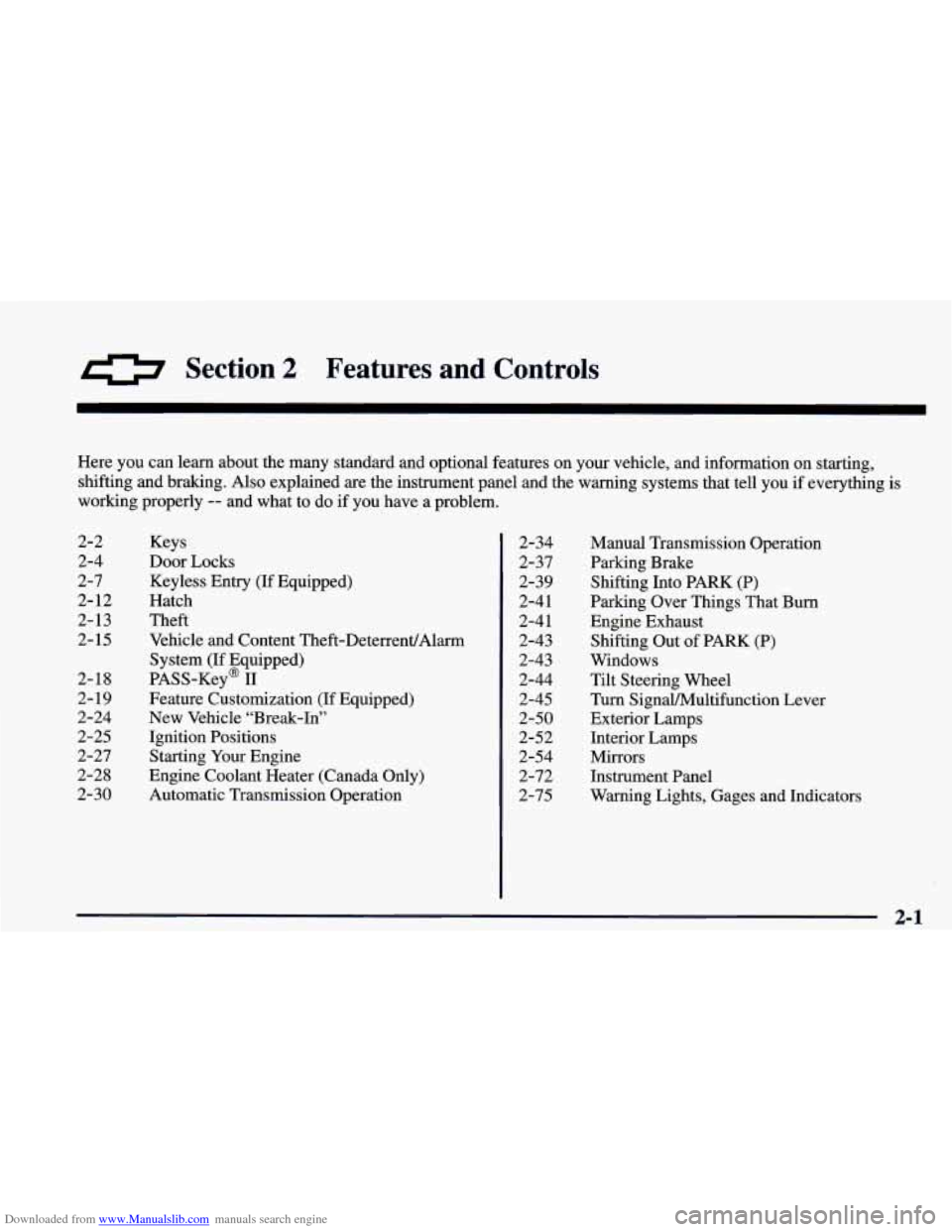
Downloaded from www.Manualslib.com manuals search engine 0 Section 2 Features and Controls
Here you can learn about the many standard and optional features on your vehicle, and information on starting,
shifting and braking.
Also explained are the instrument panel and the warning systems that tell you if everything is
working properly -- and what to do if you have a problem.
2-2
2-4
2-7
2- 12
2- 13
2- 15
2-18
2-19
2-24
2-25
2-27
2-28
2-30 Keys
Door Locks
Keyless Entry
(If Equipped)
Hatch
Theft
Vehicle and Content Theft-DeterrenVAlarm
System (If Equipped)
PASS-Key@
I1
Feature Customization (if Equipped)
New Vehicle “Break-In”
Ignition Positions
Starting Your Engine
Engine Coolant Heater (Canada Only)
Automatic Transmission Operation 2-34
2-37
2-39 2-4 1
2-4
1
2-43
2-43
2-44
2-45
2-50
2-52
2-54
2-72
2-75
Manual Transmission Operation
Parking Brake Shifting Into PARK (P)
Parking Over Things That Bum
Engine Exhaust Shifting Out
of PARK (P)
Windows
Tilt Steering Wheel
Turn SignaVMultifunction Lever
Exterior Lamps
Interior Lamps
Mirrors
Instrument Panel
Warning Lights, Gages and Indicators
2-1
Page 76 of 402
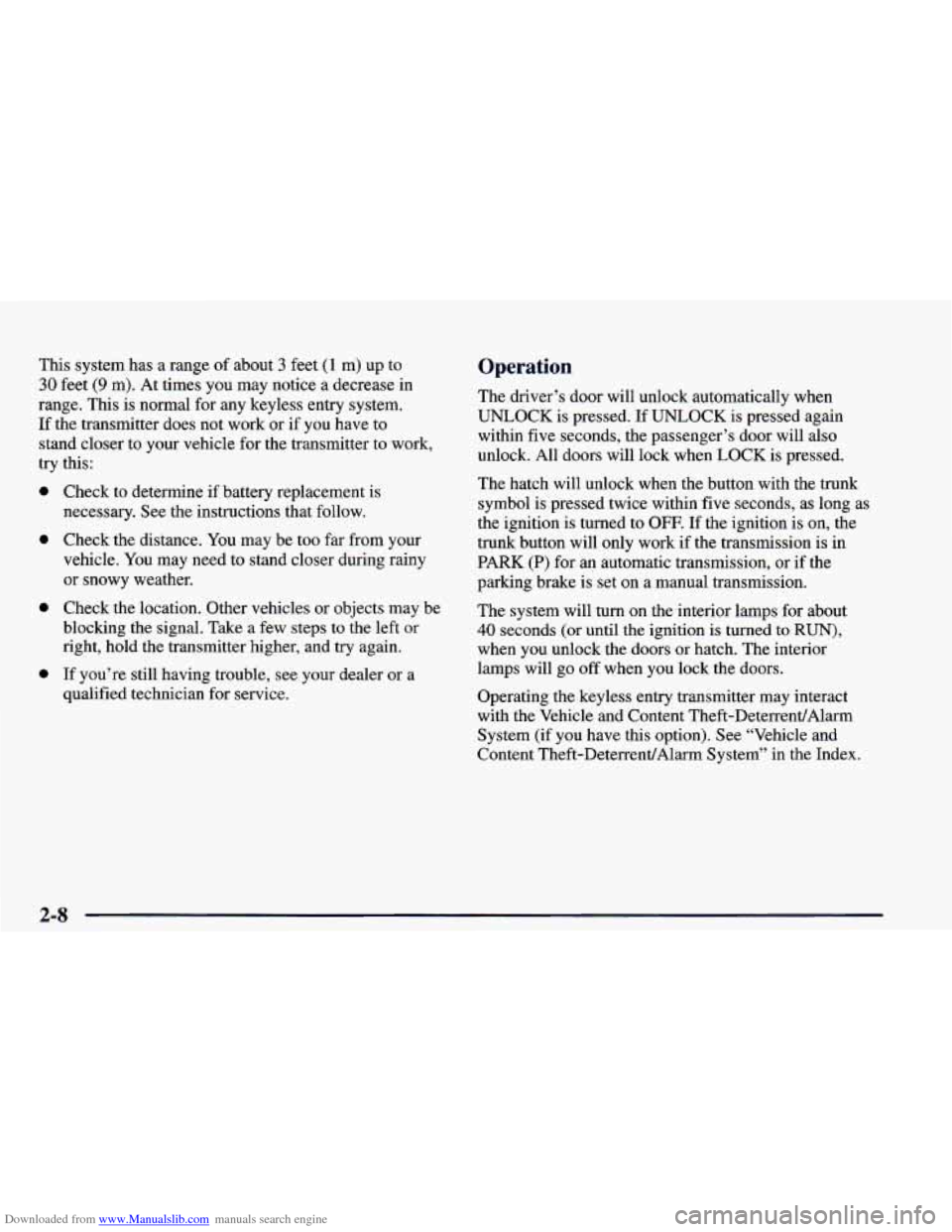
Downloaded from www.Manualslib.com manuals search engine This system has a range of about 3 feet (1 m) up to
30 feet (9 m). At times you may notice a decrease in
range. This is normal for any keyless entry system.
If the transmitter does not work
or if you have to
stand closer to your vehicle for the transmitter to work,
try this:
0
0
0
0
Check to determine if battery replacement is
necessary. See the instructions that follow.
Check the distance. You may be too far from your
vehicle.
You may need to stand closer during rainy
or snowy weather.
Check the location. Other vehicles or objects may be
blocking the signal. Take
a few steps to the left or
right, hold the transmitter higher, and try again.
If you’re still having trouble, see your dealer or a
qualified technician
for service.
Operation
The driver’s door will unlock automatically when
UNLOCK is pressed. If UNLOCK
is pressed again
within five seconds, the passenger’s door will also
unlock. All doors will lock when LOCK
is pressed.
The hatch will unlock when the button with the trunk
symbol is pressed twice within five seconds,
as long as
the ignition is turned to OFF. If the ignition is on, the
trunk button will only work
if the transmission is in
PARK (P) for an automatic transmission, or if the
parking brake is. set on
a manual transmission.
The system will turn on the interior lamps for about
40 seconds (or until the ignition is turned to RUN),
when you unlock the doors or hatch. The interior
lamps will go
off when you lock the doors.
Operating the keyless entry transmitter may interact
with the Vehicle and Content Theft-DeterrendAlarm System (if you have this option). See “Vehicle and
Content Theft-DeterrendAlarm System’’ in the Index.
2-8
Page 81 of 402
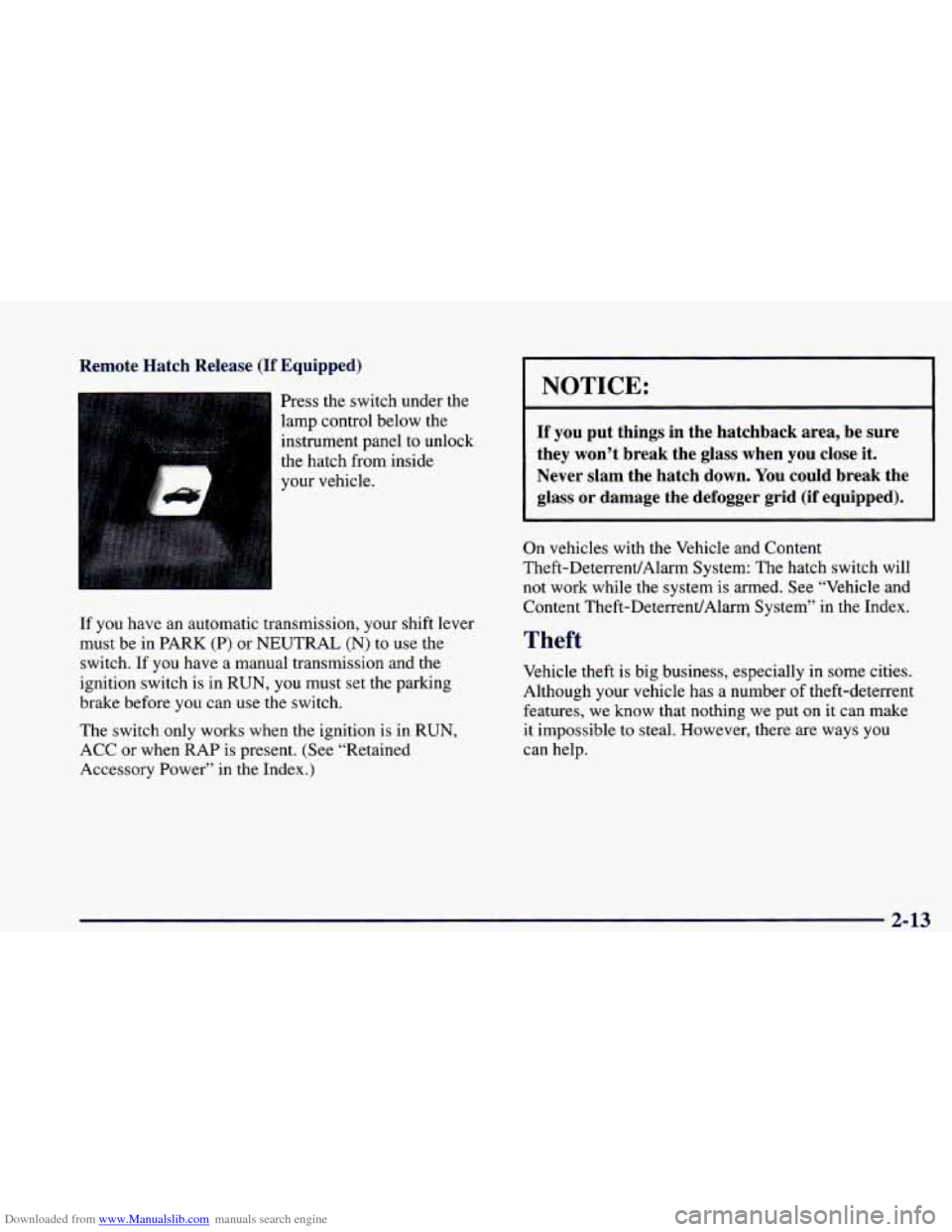
Downloaded from www.Manualslib.com manuals search engine Remote Hatch Release (If Equipped)
Press the switch under the
lamp control below the
instrument panel
to unlock
the hatch from inside
your vehicle. I
If you have an automatic transmission, your shift lever
must be in PARK
(P) or NEUTRAL (N) to use the
switch. If you have a manual transmission and the
ignition switch is in RUN,
you must set the parking
brake before you can use the switch.
The switch only works when the ignition
is in RUN,
ACC
or when RAP is present. (See “Retained
Accessory Power” in the Index.)
I NOTICE:
If you put things in the hatchback area, be sure
they won’t break the glass when you close it.
Never slam the hatch down. You could break the
glass
or damage the defogger grid (if equipped).
On vehicles with the Vehicle and Content
Theft-DeterrenUAlarm System: The hatch switch will not work while the system is armed. See “Vehicle and
Content Theft-Deteuent/Alarm System” in the Index.
Theft
Vehicle theft is big business, especially in some cities.
Although your vehicle has
a number of theft-deterrent
features, we
know that nothing we put on it can make
it impossible to steal. However, there
are ways you
can help.
2-13
Page 82 of 402
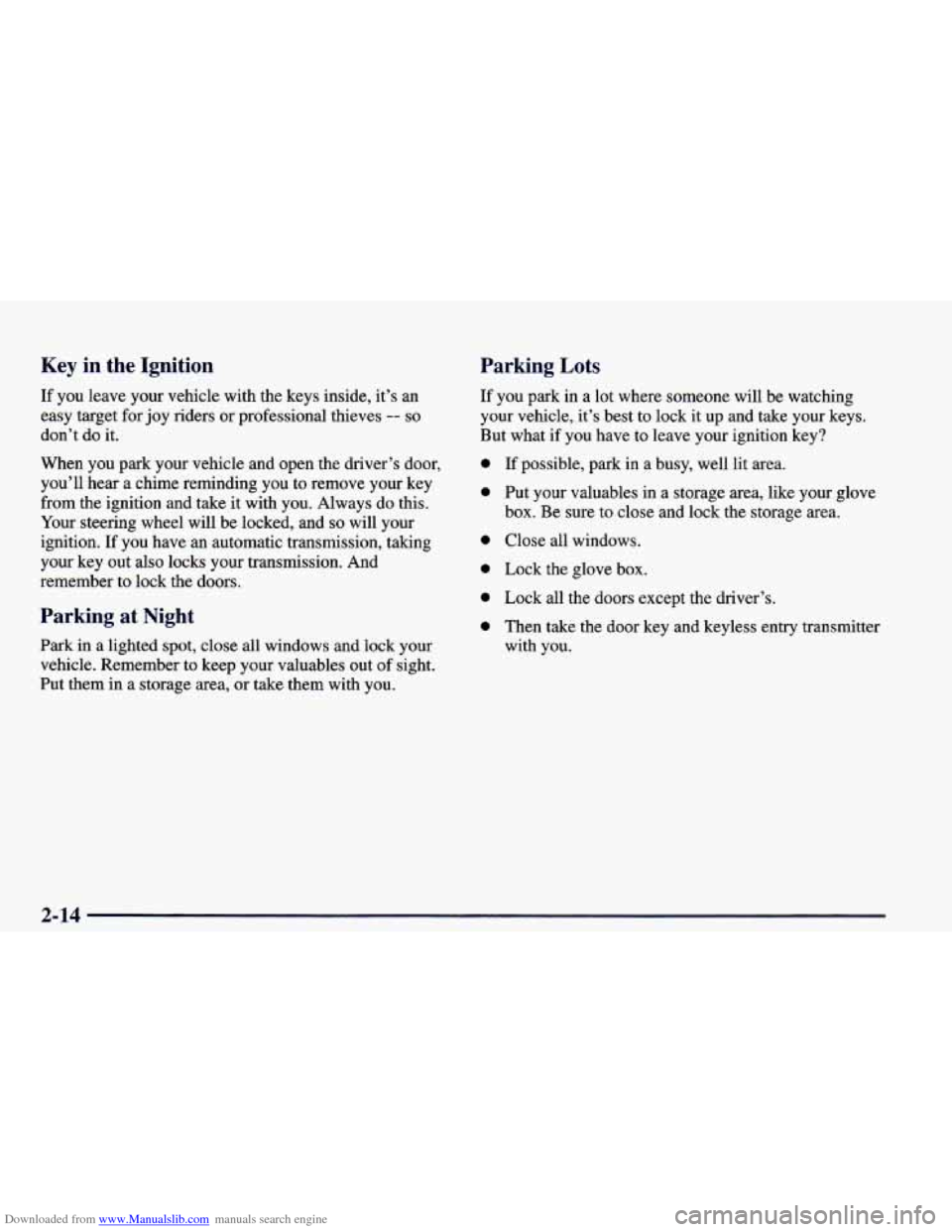
Downloaded from www.Manualslib.com manuals search engine Key in the Ignition
If you leave your vehicle with the keys inside, it’s an
easy target for joy riders or professional thieves
-- so
don’t do it.
When you park your vehicle and open the driver’s door,
you’ll hear a chime reminding you to remove your key
from the ignition and take it with you. Always do this.
Your steering wheel will be locked, and
so will your
ignition. If you have an automatic transmission, taking
your key out also locks your transmission. And
remember to lock the doors.
Parking at Night
Park in a lighted spot, close all windows and lock your
vehicle. Remember to keep your valuables out of sight.
Put them in a storage area, or take them with you.
Parking Lots
If you park in a lot where someone will be watching
your vehicle, it’s best to lock it up and take your keys.
But what if you have to leave your ignition key?
0
0
0
0
0
0
If possible, park in a busy, well lit area.
Put your valuables in a storage area, like your glove
box. Be sure to close and lock the storage area.
Close all windows.
Lock the glove
box.
Lock all the doors except the driver’s.
Then take the door key and keyless entry transmitter
with you.
2-14
Page 93 of 402
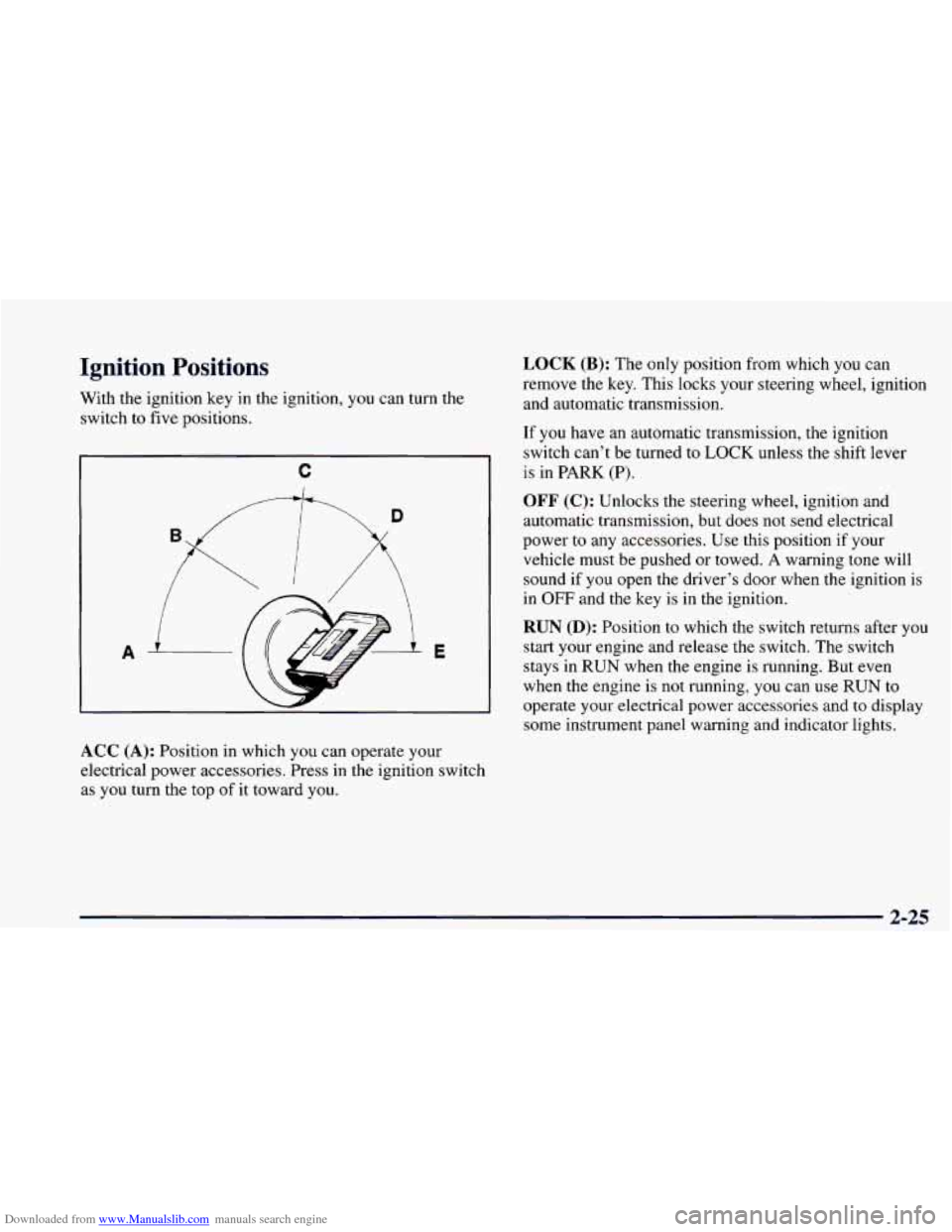
Downloaded from www.Manualslib.com manuals search engine Ignition Positions
With the ignition key in the ignition, you can turn the
switch to five positions.
C
A
/
E
ACC (A): Position in which you can operate your
electrical power accessories. Press
in the ignition switch
as you turn the top
of it toward you.
LOCK (B): The only position from which you can
remove the key. This locks your steering wheel, ignition
and automatic transmission.
If you have an automatic transmission, the ignition
switch can’t be turned to
LOCK unless the shift lever
is in
PARK (P).
OFF (C): Unlocks the steering wheel, ignition and
automatic transmission, but does not send electrical
power to any accessories. Use this position if your
vehicle must be pushed or towed.
A warning tone will
sound if you open the driver’s door when the ignition is
in
OFF and the key is in the ignition.
RUN (D): Position to which the switch returns after you
start your engine and release the switch. The switch
stays
in RUN when the engine is running. But even
when the engine is not running,
you can use RUN to
operate your electrical power accessories and to display
some instrument panel warning and indicator lights.
2-25
Page 95 of 402
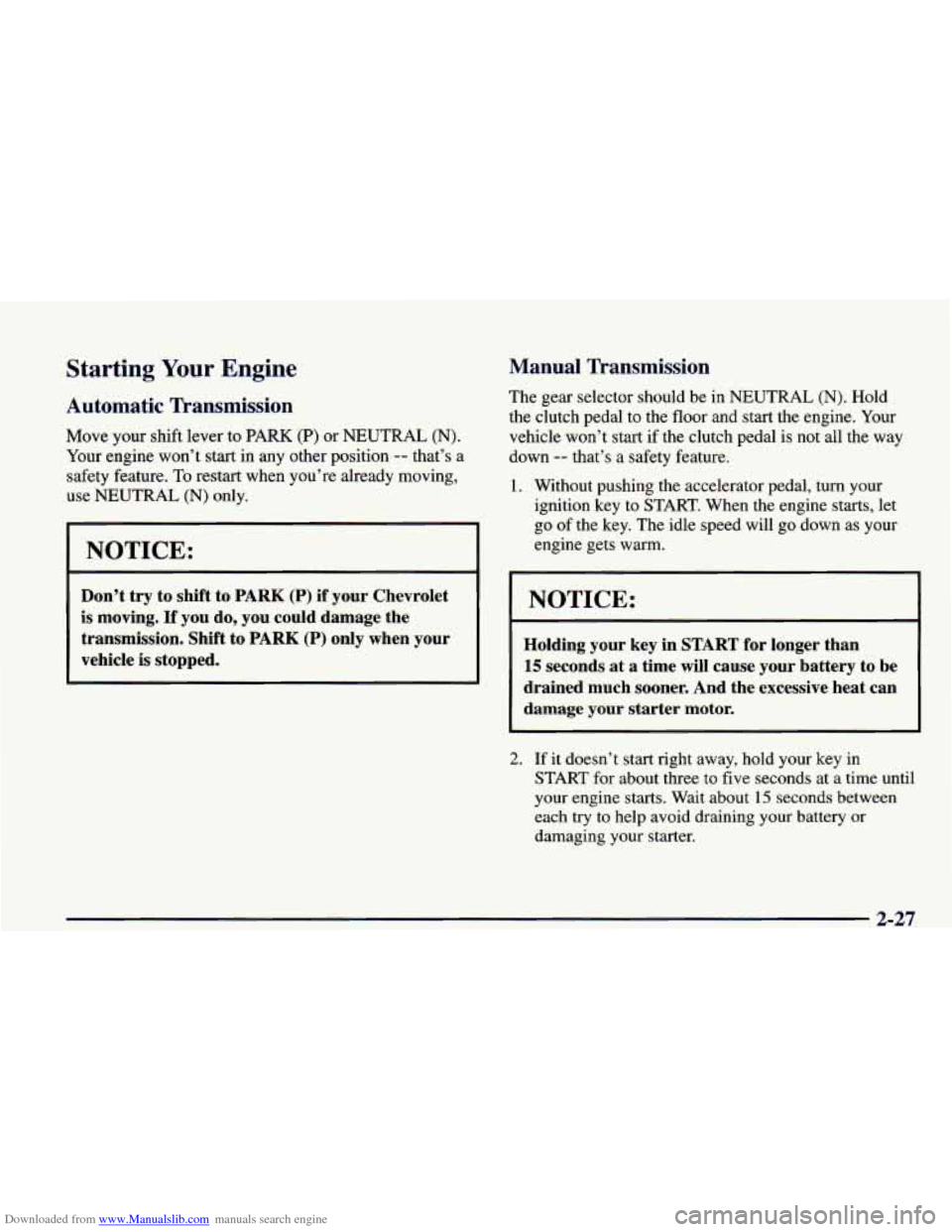
Downloaded from www.Manualslib.com manuals search engine Starting Your Engine
Automatic Transmission
Move your shift lever to PARK (P) or NEUTRAL (N).
Your engine won’t start in any other position
-- that’s a
safety feature. To restart when you’re already moving,
use NEUTRAL
(N) only.
I NOTICE:
Don’t try to shift to PARK (P) if your Chevrolet
is moving.
If you do, you could damage the
transmission. Shift to
PARK (P) only when your
vehicle is stopped.
Manual Transmission
The gear selector should be in NEUTRAL (N). Hold
the clutch pedal to the floor and start the engine. Your
vehicle won’t start if the clutch pedal is not all the way
down
-- that’s a safety feature.
1. Without pushing the accelerator pedal, turn your
ignition key to START. When the engine starts, let
go of the key. The idle speed will go down as your
engine gets warm.
NOTICE:
Holding your key in START for longer than
15 seconds at a time will cause your battery to be
drained much sooner. And the excessive heat can
damage your starter motor.
2. If it doesn’t start right away, hold your key in
START for about three to five seconds at a time until
your engine starts. Wait about
15 seconds between
each
try to help avoid draining your battery or
damaging your starter.
2-27
Page 98 of 402
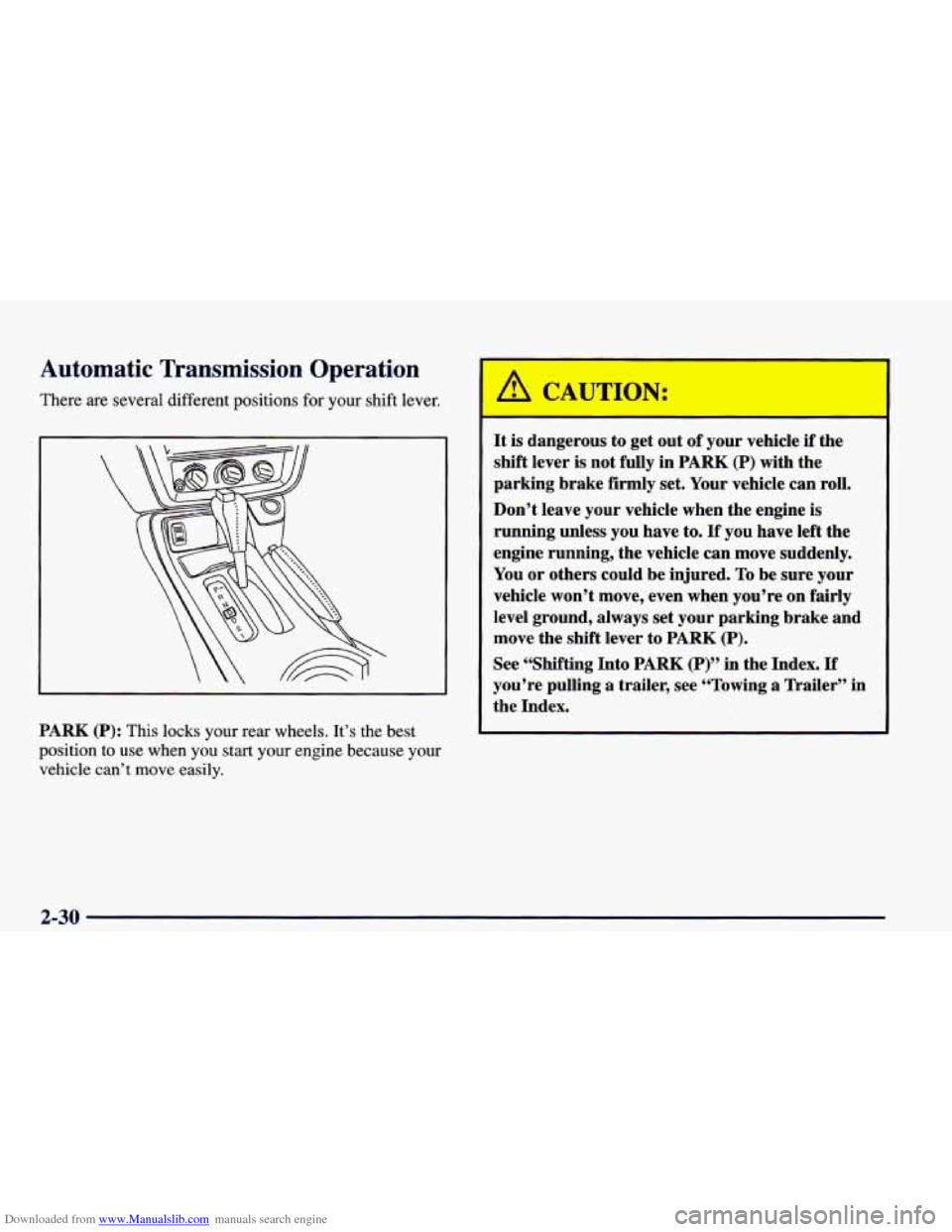
Downloaded from www.Manualslib.com manuals search engine Automatic Transmission Operation
There are several different positions for your shift lever.
PARK (P): This locks your rear wheels. It’s the best
position to
use when you start your engine because your
vehicle can’t move easily.
It is dangerous to get out or your vehicle if the
shift lever is not fully in
PARK (P) with the
parking brake firmly set. Your vehicle can roll.
Don’t leave
your vehicle when the engine is
running unless you have to.
If you have left the
engine running, the vehicle can move suddenly.
You or others could be injured.
To be sure your
vehicle won’t move, even when you’re on fairly
level ground, always set your parking brake and
move the shift lever to
PARK (P).
See “Shifting Into PARK (P)” in the Index. If
you’re pulling a trailer, see “Towing
a Trailer” in
the Index.
2-30
Page 100 of 402
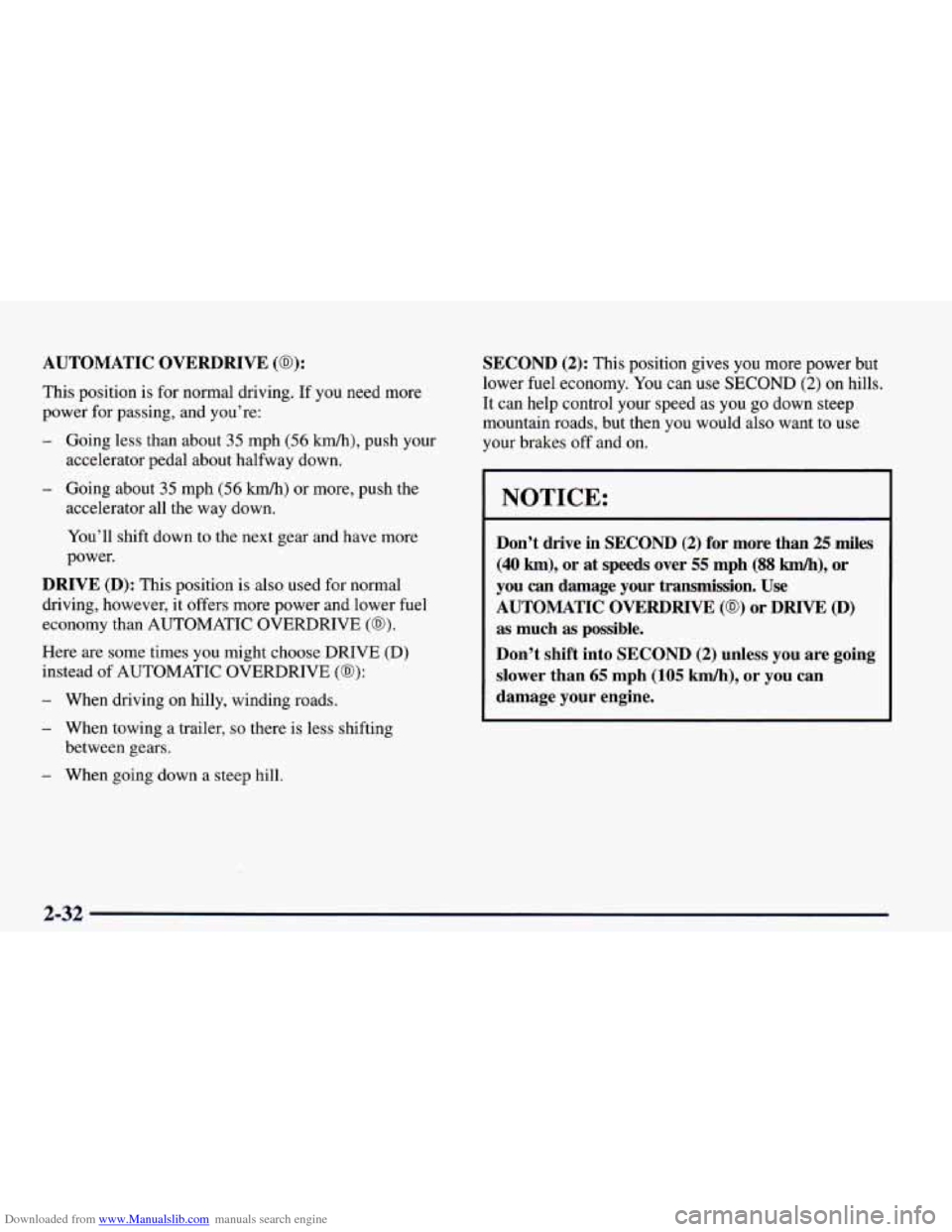
Downloaded from www.Manualslib.com manuals search engine AUTOMATIC OVERDRIVE (@):
This position is for normal driving. If you need more
power for passing, and you’re:
- Going less than about 35 mph (56 km/h), push your
accelerator pedal about halfway down.
- Going about 35 mph (56 km/h) or more, push the
accelerator all the way down.
You’ll shift down to the next gear and have more
power.
DRIVE (D): This position is also used for normal
driving, however, it offers more power and lower fuel
economy than AUTOMATIC OVERDRIVE
(@).
Here are some times you might choose DRIVE (D)
instead of AUTOMATIC OVERDRIVE
(a):
- When driving on hilly, winding roads.
- When towing a trailer, so there is less shifting
- When going down a steep hill.
between
gears.
SECOND (2): This position gives you more power but
lower fuel economy. You can
use SECOND (2) on hills.
It can help control your speed as you go down steep
mountain roads, but then you would also want to use
your brakes
off and on.
I NOTICE:
Don’t drive in SECOND (2) for more than 25 miles
(40 km), or at speeds over 55 mph (88 km/h), or
you can damage your transmission. Use
AUTOMATIC
OVERDRIVE (@) or DRIVE (D)
as much as possible.
Don’t shift into
SECOND (2) unless you are going
slower than
65 mph (105 kmk), or you can
damage your engine.
2-32
Page 101 of 402

Downloaded from www.Manualslib.com manuals search engine FIRST (1): This position gives you even more power
(but lower fuel economy) than
SECOND (2). You can-
use it on very steep hills, or in deep snow or mud. If the
selector lever is put in
FIRST (1) gear, the transmission
won’t shift into first gear until the vehicle is going
slowly enough.
NOTICE:
If your rear wheels can’t rotate, don’t try to
drive.
This might happen if you were stuck in
very deep sand or mud or were up against
a solid
object. You could damage your transmission.
Also,
if you stop when going uphill, don’t hold
your vehicle there with only the accelerator
pedal. This could overheat and damage the
transmission. Use your brakes or shift into
PARK (P) to hold your vehicle in position
on
a hill.
Maximum engine speed is limited to protect driveline
components from improper operation.
Second-Gear Start (V6 Automatic)
(If Equipped)
Your vehicle may be
equipped with a
Second-Gear Start feature.
Press the Second Gear
Start (SGS) switch on the
instrument panel to provide
more traction when you are
starting on ice or other
slippery surfaces.
The light on the switch will illuminate when Second
Gear Start (SGS) is selected. The transmission will be
in
SECOND (2) gear when the vehicle begins to
move. After starting in
SECOND (2), the vehicle will
upshift normally.
This feature is only for improved traction when the road
surface is slippery and is not intended for continuous
use. Always use
NORMAL Second Gear Start (SGS)
“OFF” for normal road conditions. You may press the
Second Gear Start (SGS) switch again to turn
off this
feature. The light
on the switch will go out. Whenever
you start your vehicle, the transmission is in the
NORMAL mode.
2-33
Page 107 of 402
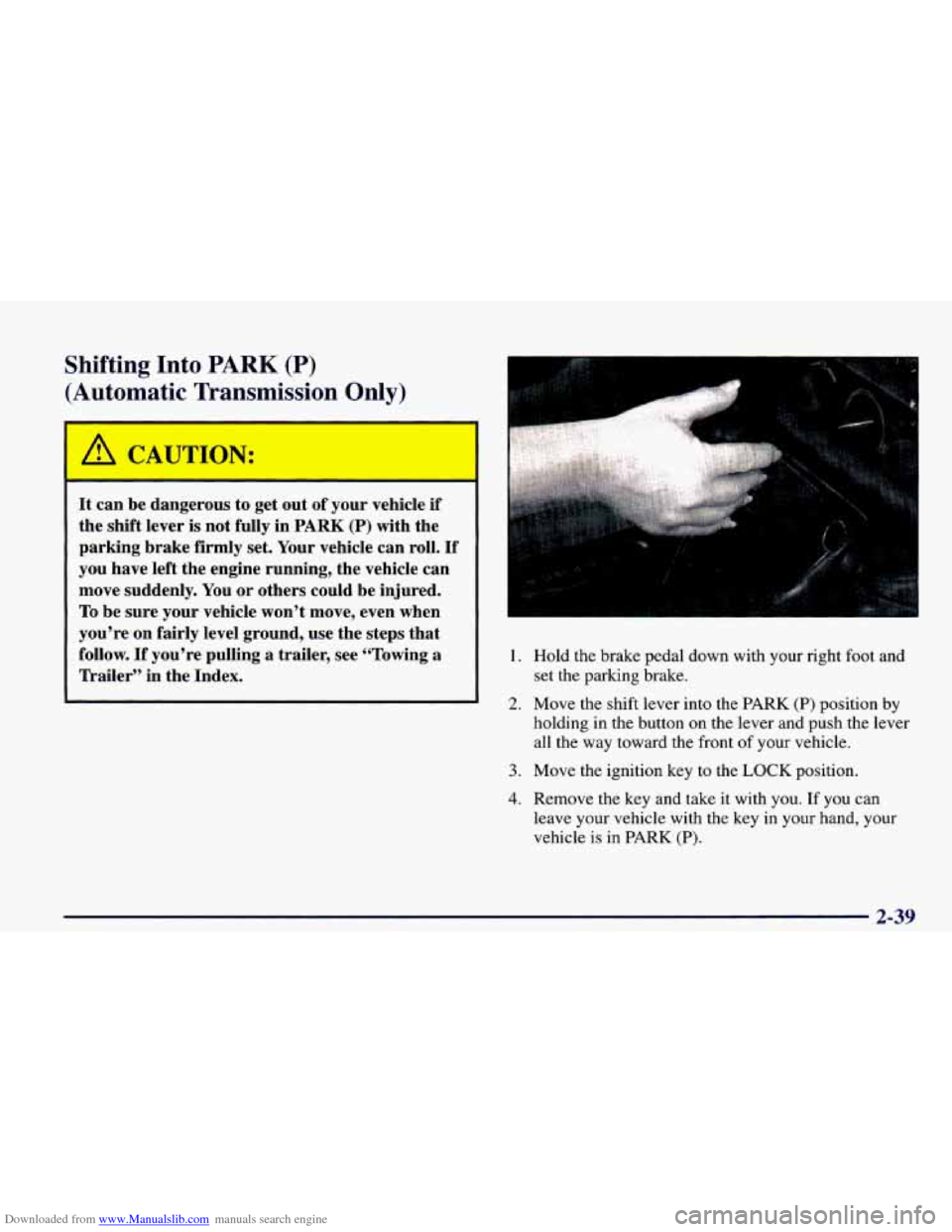
Downloaded from www.Manualslib.com manuals search engine Shifting Into PARK (P)
(Automatic Transmission Only)
A CAUTION:
It can be dangerous to get out of your vehicle if
the shift lever is not fully in PARK (P) with the
parking brake firmly set. Your vehicle can roll.
If
you have left the engine running, the vehicle can
move suddenly. You or others could be injured.
To be sure your vehicle won’t move, even when
you’re on fairly level ground, use the steps that
follow.
If you’re pulling a trailer, see “Towing a
Trailer” in the Index.
., .,. ..
..
1.
2.
3.
4.
Hold the brake pedal down with your right foot and
set the parking brake.
Move the shift lever into the PARK
(P) position by
holding in the button on the lever and push the lever
all the way toward the front
of your vehicle.
Move the ignition key to the
LOCK position.
Remove the key and take it with you.
If you can
leave your vehicle with the key in your hand, your
vehicle
is in PARK (P).
2-39